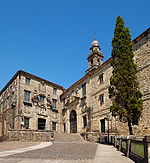Church of Santa María a Real do Sar
Bien de Interés Cultural landmarks in the Province of A CoruñaChurches in Galicia (Spain)Spanish building and structure stubsSpanish church stubs

The Church of Santa María a Real do Sar (Galician: Igrexa de Santa María a Real do Sar) is a church located in Santiago de Compostela, Spain. It was declared Bien de Interés Cultural in 1895.The church lies on the banks of the Sar river, which flows past Santiago.
Excerpt from the Wikipedia article Church of Santa María a Real do Sar (License: CC BY-SA 3.0, Authors, Images).Church of Santa María a Real do Sar
Rúa de Sar, Santiago de Compostela
Geographical coordinates (GPS) Address External links Nearby Places Show on map
Geographical coordinates (GPS)
| Latitude | Longitude |
|---|---|
| N 42.872439 ° | E -8.536989 ° |
Address
Colexiata de Santa María a Real de Sar
Rúa de Sar
15702 Santiago de Compostela
Galicia, Spain
Open on Google Maps









